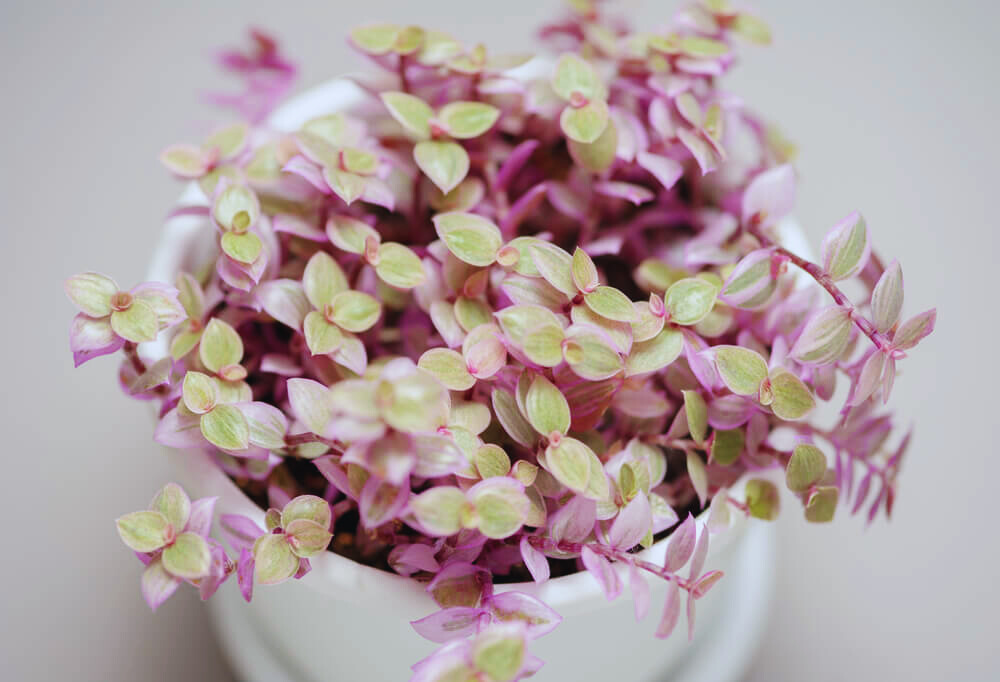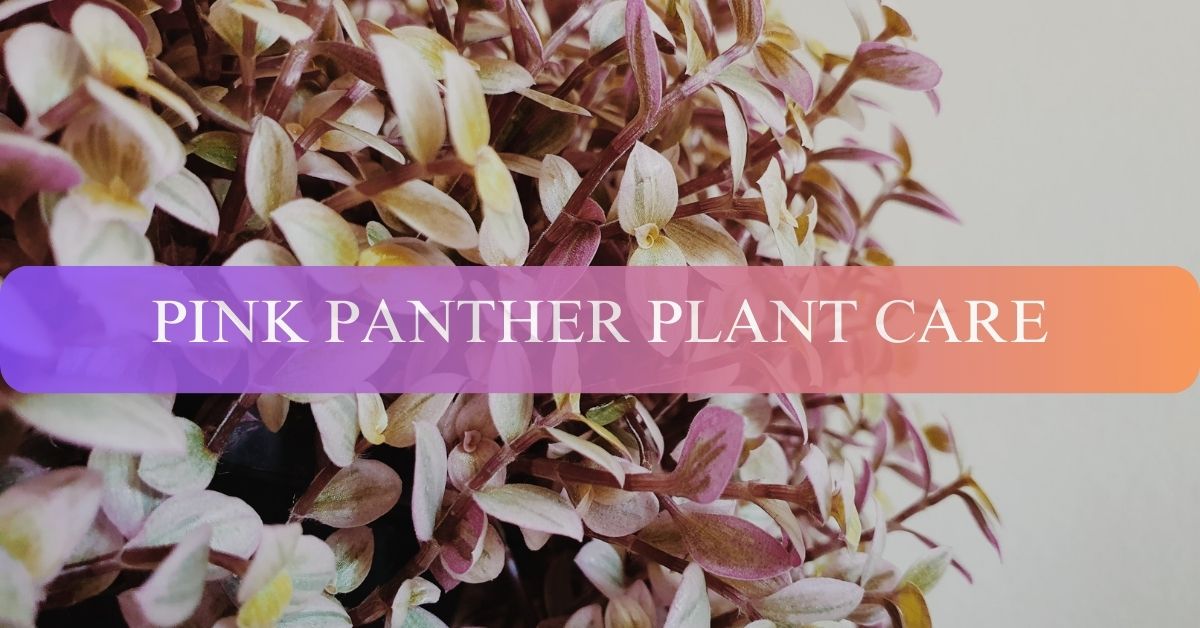Looking to add a touch of exotic beauty to your indoor space? Then you must get a Pink Panther Plant, also known as Callisia Repens or Callisia Rosato. This tropical plant will catch everyone’s attention with its stunning pink stems and lush arrowhead-shaped leaves.
But how can you care for this dynamic beauty? Pink Panther Plant care isn’t difficult, but you need to work a bit, like maintaining the ideal light and temperature conditions to watering needs, soil characteristics, and even propagation methods.
So, if you want this beautiful plant in your home, our guide will help you care for it so it remains healthy and vibrant all year round!

What Common Issues You May Face With The Pink Panther Plant?
As beautiful as the Pink Panther Plant is, we faced a few problems when we first got it. Knowing about these problems can make you aware of them to ensure your plant’s health.
So, here are some common issues you may experience:
- Yellowing leaves: If you see yellow leaves on your plant, you may be overwatering, underwatering, or your plant has poor drainage. So, adjust your watering schedule accordingly and check the soil’s moisture levels.
- Brown leaf edges: If you notice brown edges, it may indicate low humidity levels or underwatering. In this case, you should increase humidity around the plant by misting the leaves or using a humidifier.
- Pest infestations: Pests, like spider mites, aphids, and mealybugs, are the biggest problems we encounter with Pink Panther Plants. So, we started regularly inspecting our plants.
You should also follow up on your plant and take appropriate measures to eliminate them.
- Root rot: Your Pink Panther Plant can have root rot because of overwatering or poor drainage. So, ensure your plant is potted in well-draining soil and allow the top inch of the earth to dry out before watering again.
How to Care for Pink Panther Plant? [10 Tips To Follow]
Even with all the problems, you can easily keep your Pink Panther plant healthy just by following our Pink Panther indoor care tips. These ten tips work great for us, and our plant is thriving. So, let’s dive in.
1. Light Requirements
The Pink Panther Plant loves bright, indirect light. Place it near a north or east-facing window where it can receive plenty of bright, filtered sunlight. But avoid direct sunlight, as it can scorch the leaves. This tropical beauty enjoys a balance between light and shade!
However, if you notice the plant leaves becoming pale or yellowish, it might indicate that your Pink Panther is receiving too little light. Finding the right balance of light will help your Pink Panther Plant thrive and maintain its vibrant appearance.
2. Temperature Levels
We found that the temperature plays a huge role in maintaining the Pink Panther Plant. So, we always keep the temperature at 65-80°F (18-27°C) for our Pink Panther plants’ optimal growth. You should too!
You should also avoid exposing it to cold drafts or sudden temperature fluctuations, which can stress the plant.
Moreover, consistency is vital, so try to provide a stable temperature environment by checking the temperature frequently with a thermometer. Remember, temperatures below 60°F (15°C) can harm the plant, while extreme heat above 90°F (32°C) can cause leaf damage.
3. Watering Needs
You must adequately water your Pink Panther Plants for them to be healthy.
Aim to keep the soil consistently moist but not overly saturated. So, water the plant just when the top inch of soil feels slightly dry to the touch.
Moreover, ensure proper drainage using well-draining soil and a pot with drainage holes. You also need to avoid overwatering, as it can lead to root rot, while underwatering can cause the leaves to wilt.
Remember, it’s better to slightly underwater than to overwater. It will definitely help your plants!
4. Soil Characteristics
The Pink Panther Plant thrives in well-draining soil with good moisture retention.
We recommend a combination of potting soil, perlite, peat moss, and orchid bark soil mix for this tropical beauty. This mixture drains excess water, preventing waterlogging and root rot. It also retains enough moisture to keep the plant hydrated.
Additionally, avoid using heavy or compacted soils that retain too much water. Providing the Pink Panther plant with suitable soil characteristics, you’ll create an environment that promotes healthy root growth and overall plant well-being.
5. Fertilizer
To keep your Pink Panther plant thriving, regular fertilization is essential. Strengthen your plant with a liquid fertilizer every two weeks during spring and summer, which is considered the growing season.
Make sure you use a balanced liquid fertilizer for your Pink Panther plants. However, don’t add the fertilizer directly, as it can lead to over-fertilization. It’s best to dilute it to half the recommended strength.
Moreover, choose a fertilizer specifically formulated for houseplants or tropical plants. We recommend using a general-purpose houseplant fertilizer, a 20-20-20 or 10-10-10 blend, or a balanced NPK (nitrogen, phosphorus, potassium) fertilizer.
This will give your Pink Panther Plant essential nutrients for healthy growth and vibrant foliage.
6. Humidity
Like its tropical habitat, the Pink Panther Plant loves living in high-humidity environments. So, try to check and provide a humidity level of around 60-70%.
You can increase humidity by misting the leaves regularly with water or placing a tray of water near the plant. Another option we often use is a humidifier. It creates a more humid atmosphere around the plant whenever needed.
However, if the air in your home is dry, consider grouping your Pink Panther Plant with other moisture-loving plants to create a microclimate of higher humidity.
7. Potting & Repotting
You must repot your plant when it becomes root-bound or every 1-2 years. But you can’t just be quick and aggressive with the process; a gentle touch is essential here.
To repot your Pink Panther Plant, choose a one-size larger pot to accommodate growth. You also must ensure the pot has drainage holes to prevent waterlogging.
Moreover, if your plant has become root bound, slowly free the roots and carefully settle the plant into the new pot to avoid damage. Don’t forget to firm the soil around it so it doesn’t fall.
8. Pruning
Pruning is essential to Pink Panther Plant care to maintain its health and appearance.
Regularly remove yellow or damaged leaves by making clean cuts with sharp pruning shears. This enhances the plant’s aesthetic appeal and redirects its energy towards new growth.
You can also trim back excessive growth to maintain the desired shape and size.
However, remember to sanitize your pruning tools before and after each use to prevent the spread of diseases. If you practice these techniques, your plant will surely look gorgeous and healthy.
9. Propagation
We usually propagate our Pink Panther Plant to expand our plant collection. You should also try it because seeing a new plant grow is fascinating. You can try it through a popular method called division, which involves separating the plant into smaller sections with their own roots.
In this method, you must gently remove the plant from its pot and carefully separate the root clusters. Ensure that each division has healthy roots and leaves. Then, plant them in separate pots with well-draining soil and provide proper care.
Another simple method is stem cuttings. Take a 4-6 inch stem cutting with at least one node and place it in a moist potting mix. With patience and proper care, your Pink Panther Plant family will grow.
10. Pests
Dealing with pests is the most unfortunate part of plant care, but you can combat them for your Pink Panther Plant as we did.
Try spraying the leaves with water and mild dish soap or neem oil for natural pest control. This can help eliminate pests like spider mites and aphids.
Additionally, you can introduce beneficial insects like ladybugs, which feed on common plant pests.
However, if natural methods aren’t effective, consider using chemical pesticides formulated explicitly for indoor plants. Just follow the instructions carefully and apply them sparingly.
Always remember to monitor your plant’s health and adjust your pest control methods accordingly.
FAQs
How Do You Keep a Pink Panther Plant Alive?
You can easily keep your Pink Panther Plant alive by providing it with bright, indirect light, maintaining consistent moisture in the soil, and ensuring proper humidity levels.
How Much Sun Does a Pink Panther Need?
A Pink Panther plant needs bright, indirect sunlight all day.
How Big Do Pink Panther Plants Get?
Pink Panther Plants can grow up to 3 feet (1 meter) in height and have a spread of about 2-3 feet (0.6-0.9 meters). The exact size may vary depending on the plant’s age and growing conditions.
Are Pink Panther Plants Easy to Care for?
While the Pink Panther Plant is relatively easy to care for, it requires specific conditions to thrive.
Why is My Pink Panther Plant Dying?
There can be several reasons your Pink Panther Plant may die, including overwatering, underwatering, inadequate light, or pest infestations. Evaluate the plant’s care conditions and make adjustments.
Concluding Words
Your Pink Panther Plant will be a showstopper in your indoor space with the right care and attention. Its striking pink stems and lush foliage will add a touch of exotic beauty to any room.
So, embrace the joy of plant parenting, provide it with the love it deserves, and watch as your Pink Panther Plant becomes the star of your botanical collection. Get ready for a wild and vibrant journey!


